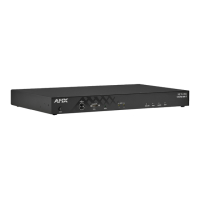Protected Setup Page
69
TPI-PRO-DVI - Instruction Manual
Protected Setup - Other Settings
Select Other Settings on the Protected Setup Page (see FIG. 67 on page 64) to open a slider with the following options (FIG. 71):
Cache - Press to access the Cache Page (FIG. 72)
Passwords - Press to access the Password Settings Page (FIG. 73 on page 71)
Protected Setup (Other Settings) - Cache Page
Select Cache from the Other Settings slider to access the Cache Page (FIG. 72):
The options on the Cache page allow you to configure the allocation of memory for image caching.
G4 Image Caching
The G4 graphics engine caches images to decrease load time of previously viewed images. RAM caching is always enabled, and
images (both static and dynamic) are stored in the RAM cache as they are viewed.
The size of RAM cache is automatically configured to take into account available memory versus memory that may be needed by
the panel later. As the RAM cache approaches its maximum size, the oldest items in the cache may be discarded to make room for
newer items.
If Flash caching is enabled, dynamic images that would have been discarded will be moved to Flash, since it is typically faster to
retrieve images on Flash than across a network.
Note that since static images are already stored on Flash, they are never moved to the Flash cache, so Flash caching applies only to
dynamic images.
Images in Flash cache are moved back to RAM cache the next time they are viewed. As the Flash cache approaches its maximum
size, the least recently used items may be discarded to make room for new items.
While RAM cache is always enabled, Flash memory can be also be allocated for image caching. However, Flash memory is a
secondary cache and is much slower than RAM cache (as it uses the local disk to store images). Flash memory should not be used
frequently, but it may be appropriate to use Flash memory in some environments that are dynamic image intensive, at times when
RAM cache is easily exhausted and the time taken to access Flash memory would be faster than network latency.
For example, when large dynamic images are being used over slow wireless links, putting the images into Flash memory can
improve performance, since the panel can spend more resources processing information rather than waiting on images to arrive
from a slow network.
FIG. 71
Protected Setup - Other Settings Slider
FIG. 72 Protected Setup (Other Settings) - Cache Page

